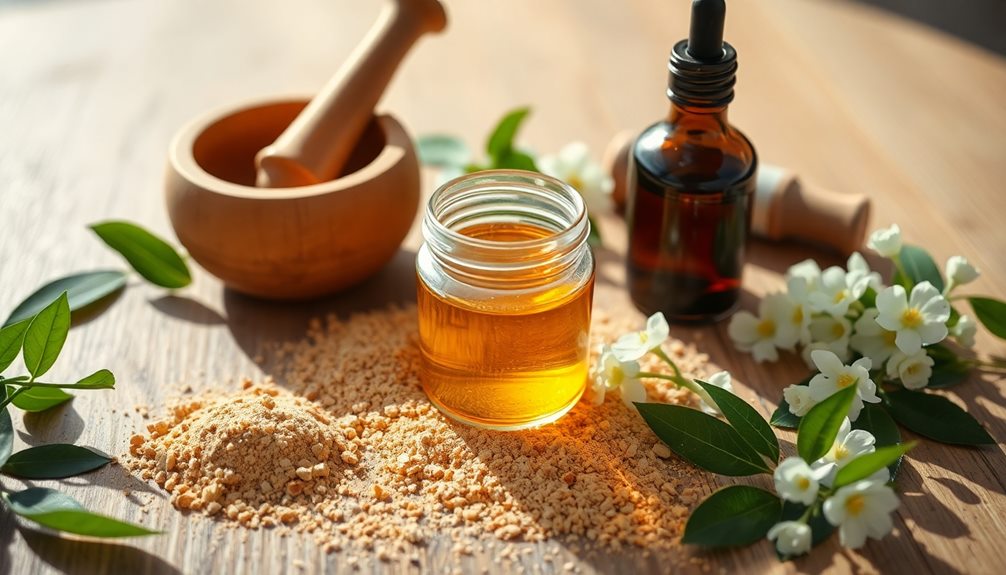Australian sandalwood oil is a fantastic addition to your skincare routine, offering multiple benefits. It has powerful healing properties, effectively treating acne and irritation while soothing inflamed skin. Its emollient qualities lock in moisture, perfect for dry or cracked areas. Plus, the anti-aging properties help enhance skin elasticity, keeping your complexion youthful. This oil not only hydrates but also provides a protective barrier against environmental aggressors. Incorporating it into your regimen is easy and rewarding. To learn how you can easily make your own sandalwood oil at home, you won't want to miss the following instructions!
Summary
- Australian sandalwood oil has antiseptic and anti-inflammatory properties, making it effective for treating acne and skin irritation.
- It creates a protective barrier, providing hydration and relieving discomfort from dry, cracked skin.
- The oil enhances skin elasticity, offering anti-aging benefits for a more youthful appearance.
- Its calming effects promote tranquility, aiding in stress relief while soothing irritated skin.
- Sandalwood oil is versatile and suitable for all skin types, easily incorporated into various skincare routines.
Skin Healing Properties
When it comes to skin healing properties, Australian sandalwood oil stands out as a powerful ally. This steam-distilled oil boasts remarkable sandalwood oil properties that make it suitable for all skin types. Its antiseptic and anti-inflammatory qualities are particularly beneficial, providing an effective anti-inflammatory skin treatment for various concerns.
Additionally, unlock radiant skin with carrot seed essential oil can complement sandalwood oil's benefits, as it promotes healthy skin and aids in reducing scars.
If you're dealing with acne, sandalwood oil could be your go-to solution. It fights bacteria while soothing inflamed skin, making it perfect for those pesky hormonal breakouts. Additionally, its emollient properties help hydrate your skin, preventing dryness and the premature appearance of wrinkles.
But that's not all—this oil also creates a protective barrier against environmental aggressors, which is especially helpful during harsh weather. If you struggle with dry, cracked skin, sandalwood oil can quickly relieve discomfort, returning moisture to areas like your heels.
Incorporating Australian sandalwood oil into your skincare routine can elevate your skin's health while promoting a more radiant appearance. Whether you're battling acne or simply looking to maintain hydration, this oil is a versatile addition that your skin will thank you for!
Resource-Intensive Production Process
The production of Australian sandalwood oil is a fascinating blend of patience and dedication, reflecting the resource-intensive nature of this sought-after essential oil. It takes up to 10 years for the sandalwood tree to mature before it can be harvested. This lengthy process underscores the commitment required to produce high-quality oil.
Here's a closer look at the key aspects of this production process:
| Aspect | Details |
|---|---|
| Maturation Time | Up to 10 years |
| Harvesting Method | Sustainable practices are essential |
| Extraction Technique | Steam distillation |
| Yield | Low yield per tree |
| Environmental Impact | Concerns over deforestation |
Due to the dedication involved, creating homemade sandalwood essential oil is an alternative that some may explore. However, remember that the quality may vary compared to professionally extracted Australian sandalwood oil. Understanding this resource-intensive process helps you appreciate the value and effort behind every drop of this luxurious oil, whether you're using store-bought or your own homemade sandalwood essential oil.
Homemade Sandalwood Oil Instructions
Creating your own Australian Sandalwood Oil at home can be a fulfilling project, allowing you to enjoy the numerous skin benefits of this precious essential oil. Sandalwood oil is known for its soothing properties, making it an excellent addition to your skincare routine. By making your own oil, you can guarantee it's free from additives and preservatives, resulting in a product that's pure and tailored to your needs.
The process is simple and requires just a few ingredients, making it accessible even for beginners in essential oil crafting. Discover the benefits of agarwood oil.
Before you start, it's important to select high-quality sandalwood chips or powder, as the quality of your final product will depend heavily on the raw materials you use. This homemade oil can be used for various skin concerns such as acne treatment, hydration for dry skin, and even as a soothing aid for chapped areas.
Follow the instructions carefully, and soon you'll have your own bottle of nourishing sandalwood oil ready for use.
Ingredients:
- Sandalwood powder or chips
- Virgin olive oil (1 cup)
Instructions:
Begin by using a mortar and pestle to crush the sandalwood chips into a fine powder. In a glass jar, combine the crushed sandalwood with one cup of virgin olive oil.
Seal the jar tightly and let the mixture sit in a cool, dark place for one week, shaking it gently every few days to help infuse the oil. After a week, strain the mixture through a fine mesh or cheesecloth to extract the oil, pressing the sandalwood powder to guarantee you get as much oil as possible.
Ultimately, transfer the extracted oil into a clean glass bottle and store it in a dark, cool place to maintain its potency.
Extra Tips:
When making sandalwood oil, always perform a patch test on a small area of your skin to check for any allergic reactions before using it more broadly.
Additionally, consider using a dark glass bottle for storage, as this helps protect the oil from light, which can degrade its quality over time.
Homemade Oil Infusion Process
Infusing oils at home can be a rewarding experience that allows you to harness the power of various botanicals, like Australian Sandalwood. The calming properties of essential oils, such as Balsam Fir can complement your homemade infusion beautifully.
To create your own sandalwood oil, you'll need sandalwood powder or chips and virgin olive oil. This process is straightforward and gives you a personalized oil that's perfect for skin care with sandalwood.
Start by crushing your sandalwood chips into a fine powder using a mortar and pestle. Then, in a glass jar, mix the crushed sandalwood with one cup of virgin olive oil.
Seal the jar tightly and let it sit in a cool, dark place for about a week. Be certain to shake it occasionally to help the infusion process.
After a week, strain the mixture through a fine mesh sieve or cheesecloth to extract the oil, pressing down on the sandalwood to maximize your yield.
Your homemade sandalwood oil can now be used in various skin care routines. Remember to perform a patch test before applying it to larger areas to ascertain you don't have any allergic reactions.
Enjoy your DIY sandalwood oil recipe and the benefits it brings to your skin!
Step 1. Crush Sandalwood Into Powder
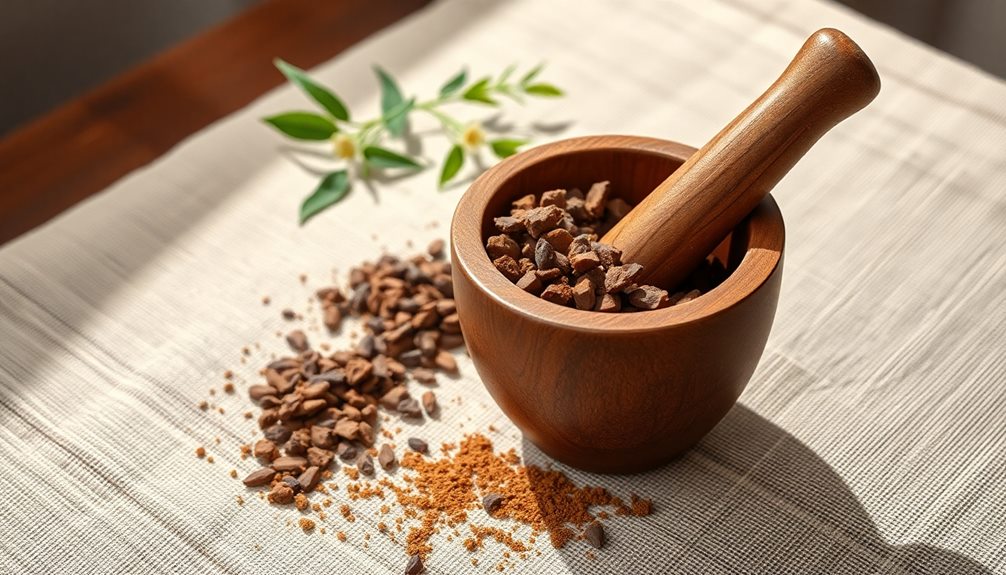
To begin your journey in making homemade sandalwood oil, you'll need to crush the sandalwood into a fine powder. This step is essential because the finer the powder, the more effectively it infuses into the olive oil, maximizing the benefits of your DIY sandalwood oil.
A mortar and pestle are ideal for this task, allowing you to control the texture. Here are some common uses for sandalwood powder to inspire you:
| Sandalwood Powder Uses | Benefits | Application |
|---|---|---|
| Aromatherapy | Calms the mind | Add to diffusers |
| Skin Care | Hydrates and soothes | Mix with carrier oils |
| Natural Deodorant | Neutralizes odors | Combine with baking soda |
| DIY Face Masks | Cleanses and brightens skin | Blend with yogurt or honey |
Once you've achieved a fine consistency, you're ready to move on to the next step in your sandalwood oil creation. This powder isn't just for oil; it's versatile for various beauty applications. Enjoy the process, knowing you're crafting something beneficial for your skin!
Step 2. Combine With Olive Oil
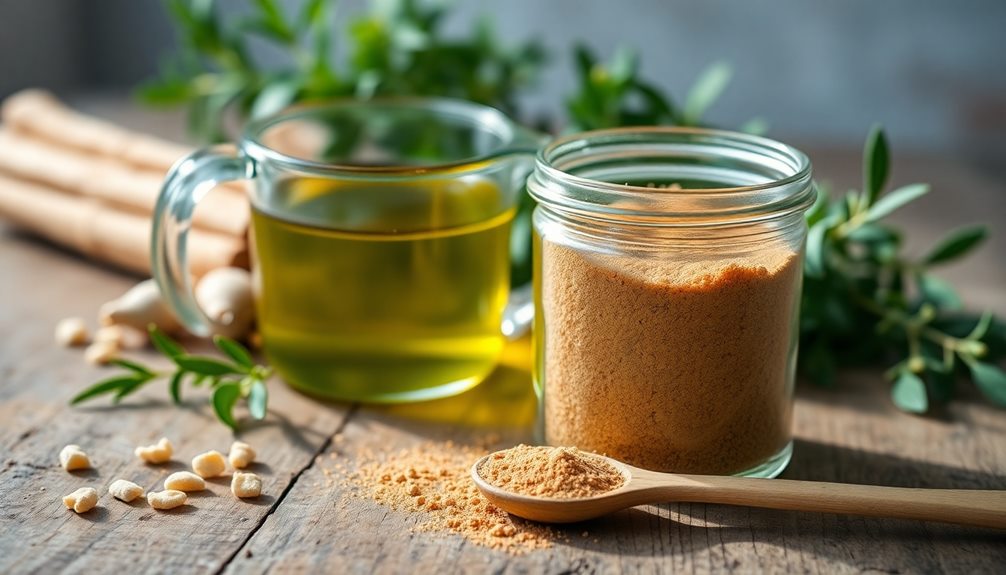
After you've finely crushed the sandalwood into a powder, the next step involves combining it with olive oil to extract the oil's beneficial properties.
Cedarwood essential oil, known for its calming properties, can also complement this blend, enhancing relaxation while promoting skin health discover the calming benefits. Olive oil acts as a carrier oil, enhancing the absorption of sandalwood oil into your skin. This combination creates a powerhouse blend that's perfect for targeting cracked heels and dry skin.
To make this blend, mix one cup of virgin olive oil with your crushed sandalwood in a glass jar. Olive oil is known for its emollient properties, making it an excellent option for hydration. It not only nourishes your skin but also forms a protective barrier, locking in moisture and preventing further dryness.
Once combined, let the mixture sit for a week, shaking it occasionally to maximize the infusion. After this period, you'll have a rich, aromatic oil that offers incredible benefits.
Use this sandalwood oil for cracked heels by massaging it into the affected areas. You'll notice how the emollient oils work to soothe and rejuvenate your skin, leaving your feet feeling smooth and refreshed. Embrace this natural remedy and enjoy the skin-loving benefits of your homemade sandalwood oil!
Step 3. Strain to Extract Oil

Once you've allowed your sandalwood and olive oil mixture to sit for a week, it's time to strain the oil and reveal its soothing properties.
Begin by grabbing a fine mesh strainer or cheesecloth. Place it over a clean glass bowl or jar to catch the oil. Carefully pour the mixture through the strainer, allowing the liquid to flow while retaining the sandalwood powder. You can gently press the powder with a spoon to extract more oil, ensuring you get every drop of that precious sandalwood oil.
Once the oil is fully strained, transfer it to a dark glass bottle for storage. This helps protect it from light, which can degrade its quality.
Now you have your homemade sandalwood oil, which is excellent for various skin concerns, especially when dealing with acne.
Remember, before applying it to your skin, it's essential to conduct a patch test for essential oils. Just dab a small amount on your wrist and wait for 24 hours to check for any allergic reactions.
Enjoy the skin benefits of your new sandalwood oil, and incorporate it into your skincare routine with confidence!
Step 4. Press for Maximum Extraction
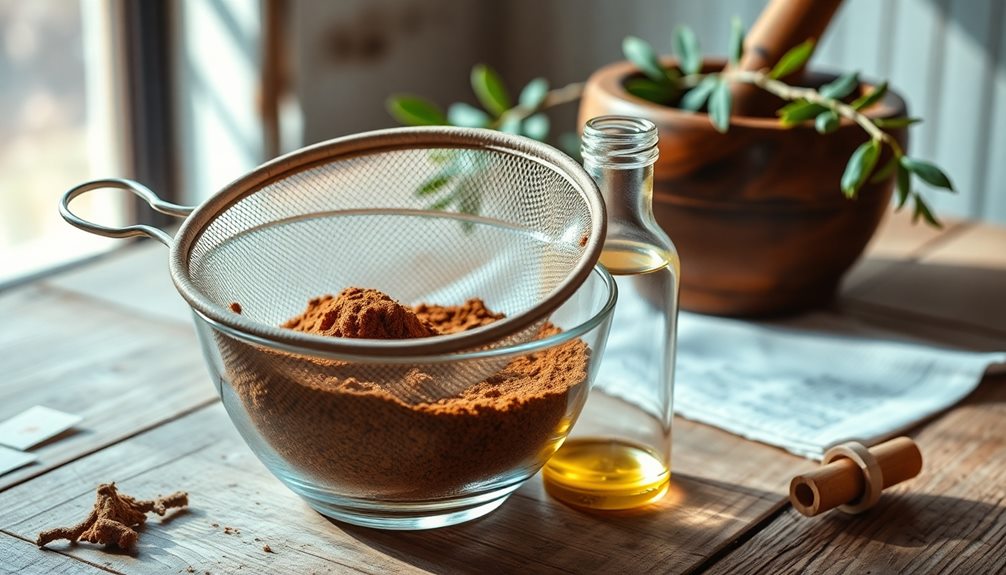
Maximizing oil extraction from your sandalwood mixture is essential for ensuring you benefit from every drop of this precious oil. After allowing your sandalwood and olive oil blend to steep, the next vital step is pressing. This process allows you to extract the maximum amount of essential oils for skin health, ensuring you're not wasting any valuable components.
Cedarwood essential oil, known for its calming and grounding properties, is also a great addition to skincare routines, as it can enhance the overall effects of your sandalwood blend by embracing nature's benefits.
To press effectively, use a clean, sturdy cloth or cheesecloth. Place the soaked sandalwood powder inside and twist the cloth to create pressure. As you press, you'll notice the oil seeping out. This oil is rich in hydrating and anti-aging properties, making it a fantastic addition to your skincare routine.
Step 5. Store in Dark Glass Bottle
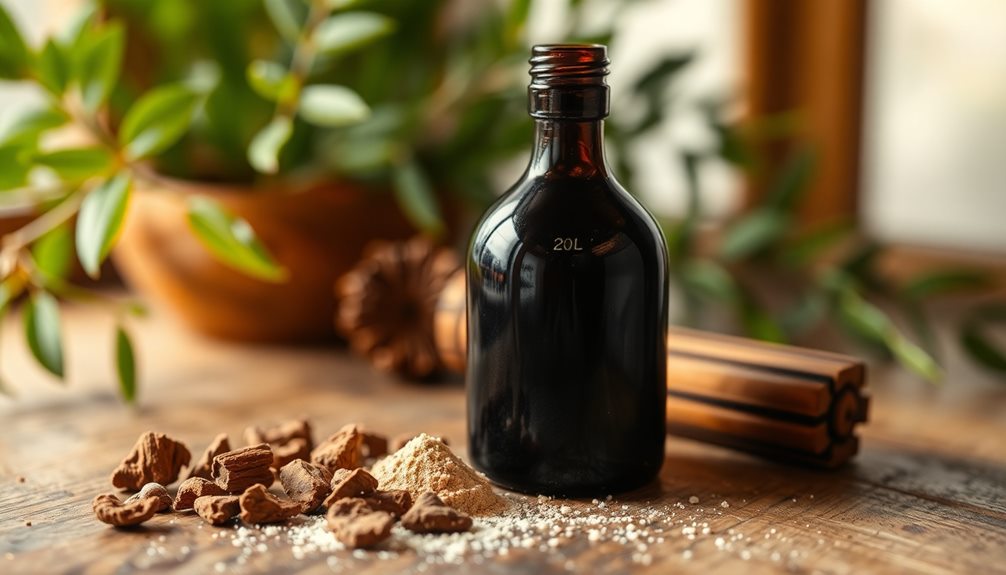
To preserve the potency and integrity of your homemade sandalwood oil, storing it properly is key. Using a dark glass bottle is essential for protecting the oil from light exposure, which can degrade its quality over time. This method guarantees you maintain the benefits of sandalwood oil for skin, allowing you to enjoy its natural skin care ingredients to their fullest.
Here's a quick guide on why you should choose dark glass bottles:
| Reason | Explanation |
|---|---|
| Light Protection | Dark glass shields your oil from UV rays, preventing degradation. |
| Chemical Stability | Glass doesn't leach chemicals, keeping your oil pure. |
| Temperature Regulation | Glass helps maintain a stable temperature, preserving oil quality. |
| Eco-Friendly | Reusable and recyclable, it's a sustainable choice. |
| Aesthetic Appeal | Dark glass looks elegant, enhancing your natural skin care collection. |
Final Thoughts
When it comes to nurturing your skin, Australian sandalwood oil stands out as a truly remarkable natural remedy. With its diverse benefits, this oil is perfect for skin care for all skin types, ensuring everyone can enjoy its healing properties.
Whether you're dealing with acne, signs of aging, or simply need hydration, sandalwood oil offers effective solutions. Additionally, like the calming and purifying properties of Palo Santo essential oil, sandalwood oil can enhance your overall skincare experience.
One of the standout features of this oil is its calming properties. It not only soothes irritated skin but also provides a sense of tranquility, making it ideal for those stressful days.
Additionally, its emollient qualities help maintain hydration, preventing dryness and cracking, especially during harsh weather conditions.
Using Australian sandalwood oil in your skincare routine can transform your skin, helping you feel more confident and comfortable.
FAQ
Can Sandalwood Oil Be Used for Sensitive Skin?
Yes, sandalwood oil can be used for sensitive skin. Its gentle, anti-inflammatory properties soothe irritation and redness. Just remember to perform a patch test first, ensuring it doesn't cause any adverse reactions.
How Long Does Sandalwood Oil Last When Stored Properly?
When stored properly in a cool, dark place, sandalwood oil can last up to five years. Just make sure the container's airtight and avoid exposure to light or heat to maintain its quality.
Are There Any Side Effects of Using Sandalwood Oil?
When using sandalwood oil, you might experience skin irritation or allergic reactions. Always perform a patch test first. If you notice redness or discomfort, discontinue use and consult a healthcare professional for guidance.
Can Sandalwood Oil Be Mixed With Other Essential Oils?
Yes, you can mix sandalwood oil with other essential oils. Just blend it with oils like lavender or tea tree for enhanced benefits. Always test the mixture on a small skin area to verify compatibility.
Is It Safe to Use Sandalwood Oil During Pregnancy?
During pregnancy, it's best to avoid using sandalwood oil without consulting your healthcare provider. While it's generally safe for many, individual reactions can vary, so ensuring your safety and your baby's is essential.
